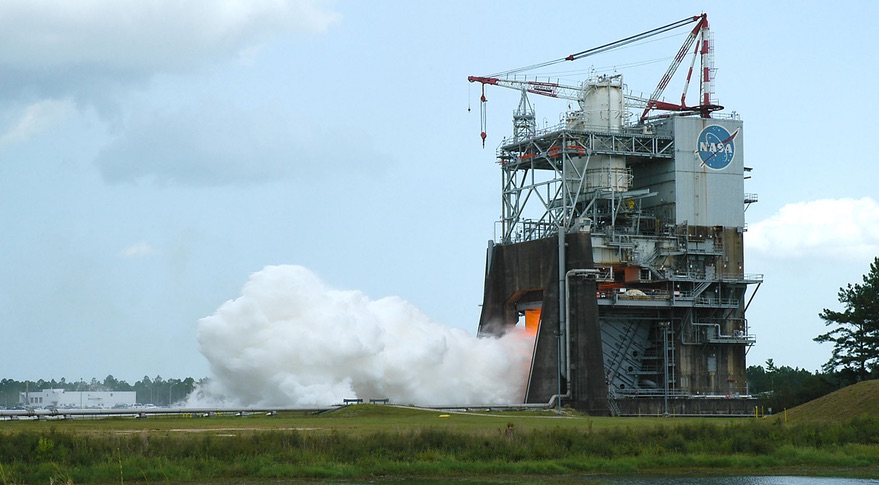NASA Says RS-25 Engine Test for New Megarocket a Success Despite Ending Early
WASHINGTON — NASA says an Aug. 14 test of an engine for the Space Launch System was a success despite an unspecified "facility issue" that caused the test to end early.
The test of the RS-25 engine on the A-1 stand at the Stennis Space Center in Mississippi was the first in a new series of static-fire tests of the shuttle-era engine that will be used in the core stage of the SLS. The engine, a developmental unit designated No. 0525, tested a flight controller unit that will be used on flight models of the engine as well as new manufacturing techniques intended to reduce the cost of future engines.
NASA Stennis announced prior to the test that the test would run for eight minutes and 20 seconds. However, in a tweet after the test, Stennis said the test ended after five minutes and 19 seconds. [NASA's Space Launch System Megarocket in Pictures]
An Aug. 15 statement from Stennis about the test made no mention of the planned or actual duration of the test. "All test objectives were met during the hot fire," the center's statement noted.
Stennis spokesperson Valerie Buckingham confirmed Aug. 15 that the test was cut short. "The test ended early due to a facility issue, but all test objectives were met," she said in an emailed response to a SpaceNews inquiry. She later said she didn't know the details about the problem, other than it did not damage the engine itself.
Aerojet Rocketdyne, which manufactures the RS-25, also said the test ended early because of a facility problem, but deferred questions on the issue to NASA Stennis. The company said in a statement that the engine performed as expected.

Among the objectives of the test was to test a new manufacturing approach called hot isostatic pressing for the engine's main combustion chamber that the company says "saves considerable time and money" over conventional techniques. "Initial test data indicates the chamber performed flawlessly during the 319-second test," Aerojet Rocketdyne said.
Get the Space.com Newsletter
Breaking space news, the latest updates on rocket launches, skywatching events and more!
That technique is being evaluated for use on future versions of the RS-25. The first four SLS missions will use existing engines, originally manufactured for the space shuttle and updated for SLS. Later SLS launches will require new RS-25 engines.
"As we develop a new generation of RS-25 engines, ensuring they continue to remain reliable while reducing costs is a major focus at Aerojet Rocketdyne," said Eileen Drake, chief executive and president of the company. "That's why we're working hard to drive down costs on the RS-25 by incorporating the most modern and efficient manufacturing techniques."
NASA is planning eight more tests using the same developmental RS-25 engine that will go through early 2019. Later in 2019, another test stand at Stennis will host a "green run" static-fire test of the first SLS core stage, where its four RS-25 engines will fire simultaneously.
Among those attending the test was NASA Administrator Jim Bridenstine, making his first visit to Stennis since becoming administrator. The visit was part of a series of appearances at NASA facilities in the region that included the Michoud Assembly Facility in New Orleans Aug. 13 and the Marshall Space Flight Center in Huntsville, Alabama, Aug. 15.
In a webcast of the launch, Bridenstine didn't appear to be aware that the test had been cut short. "I've seen a lot of launches as a member of Congress before and now as NASA administrator, but the rockets always leave," he said. "In this particular case, the rocket stayed, and it stayed for 500 seconds of just a heart-pounding thrust."
He reiterated the importance of the SLS in carrying out human missions to the moon and beyond despite the vehicle's years of delays. "This is our opportunity to follow through on the president's Space Policy Directive 1, which says that we're going to the moon," he said, saying the SLS fits into a "sustainable" architecture where "we want every piece of this architecture to ultimately be reusable." The SLS is currently an expendable vehicle, including the original shuttle-era RS-25 engines that were designed for reuse.
This story was provided by SpaceNews, dedicated to covering all aspects of the space industry.
Join our Space Forums to keep talking space on the latest missions, night sky and more! And if you have a news tip, correction or comment, let us know at: community@space.com.

Jeff Foust is a Senior Staff Writer at SpaceNews, a space industry news magazine and website, where he writes about space policy, commercial spaceflight and other aerospace industry topics. Jeff has a Ph.D. in planetary sciences from the Massachusetts Institute of Technology and earned a bachelor's degree in geophysics and planetary science from the California Institute of Technology. You can see Jeff's latest projects by following him on Twitter.










